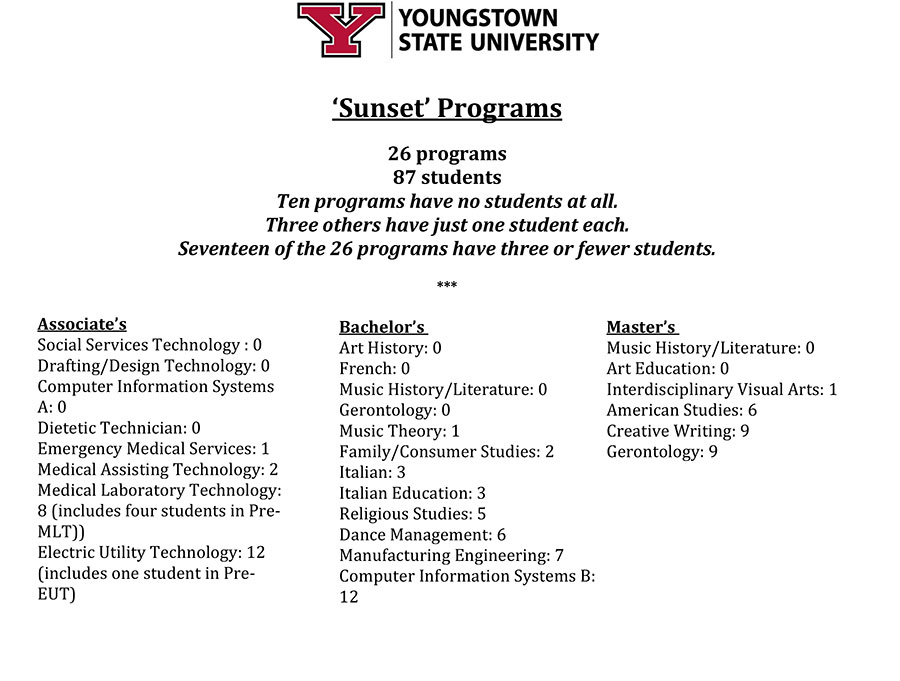YSU in Dire Financial Straits? Administration, Union Differ
Updated Nov. 11, 6:30 a.m. | Additional details about non-faculty staff cuts in FY 2020.
YOUNGSTOWN, Ohio — During a virtual press conference addressing renrollment, budgeting and program cuts at Youngstown State University, administration representatives contend the cuts are about positioning YSU for long-term sustainability.
YSU Vice President of Finance Neal McNally emphasized during the conference that the university is “not in dire straits,” and is “fiscally sound overall.” However, to preserve that financial health, YSU needs to take steps today “to ensure a brighter future for tomorrow,” he said.
“I don’t mean to imply that the university can right-size itself overnight,” McNally said. “We cannot cut ourselves into prosperity.”
But that’s not what the YSU Chapter of the Ohio Education Association says it’s hearing, according to Mark Vopat, spokesman.
The university’s message to the union has indeed been one of dire financial straits, and that the only way to shore up the budget and get it back to breaking even was to cut faculty, he told The Business Journal in a phone interview following the press conference.
“If we’re not in a budget crunch, then I’m not sure why we’re going this fast,” Vopat said. “Retrenchment of faculty is one of the last resorts a university uses. Normally when you get to this point, it’s because you’re in dire straits.”

YSU plans to deactivate 26 academic programs identified as “sunset” by a university initiative, which looked at more than 140 academic programs across the campus to assess market and student demand, competition from other universities, job prospects for students enrolled in those majors and the overall cost to the university of offering the programs.
According to YSU, those programs currently have 87 students – 10 of the programs have none, while three others have one each. Cutting the programs will also lead to the loss of 20 or fewer faculty members.
As for whether this will be enough to right-size the university, McNally said this exercise is the beginning, and “I look at the process we’re employing now to be something that becomes more of an annual routine” in terms of establishing the budget and priorities. He emphasized any plans moving forward must be a balanced approach and “can’t just be cutting expenses.”
The academic program review initiative was conducted with the assistance of the faculty, as well as deans, department chairs and members of the Academic Senate, said Brien Smith, provost and vice president of academic affairs.
However, because of an 11% drop in fall 2021 enrollment from three years ago to a record low of 11,298 students – created by regional demographic trends leading to smaller high school graduating classes, a more competitive higher education market, and the COVID pandemic – YSU still faces a potential structural budget deficit in excess of $10 million next fiscal year after millions in temporary COVID-related funds are exhausted, officials have said.
Vopat reiterated the OEA’s request for a performance audit that looks at the university as a whole – academics, athletics and administration – before enacting the cuts. He says faculty have come to the table when considering improving academic efficiencies, such as increasing class sizes and determining the return-on-investment for academic departments and programs.
But when the union asks to apply that same standard to non-academic sectors, the response from the university has been “No, we’re not going to look at that,” Vopat said.
“I’m unclear why we’re not looking at all those other sectors,” he said. “The primary function of the university is teaching students. What we’re doing is limiting those opportunities.”
During the press conference, YSU’s McNally likened the request for the administrative audit as a “stall tactic” on behalf of the union.
Per contractual obligation, the university has until Nov. 15 to notify faculty of whether they will be retained for the fall 2022 semester. Thus, waiting a month or six weeks to perform such an audit would prevent YSU from missing that window, and any decisions made then regarding faculty would have no impact on the fall 2022 semester, McNally explained.
“We have to start now to reduce faculty levels for next year,” he said.
In March 2020, the university had a “strong response” to the challenges presented by the COVID pandemic, said Provost Brien Smith, also vice president of academic affairs. At the time, “I was determined to do everything that I could possibly do to spare the faculty” while making cuts in other areas.
As enrollment continues to decline, Smith said, now the university has to turn its attention to the faculty and potential cuts.
“You have to look at this not as a sliver in time right now, but the whole picture really since the pandemic started,” Smith said.
At the beginning of the last fiscal year, YSU demonstrated it has “a relatively high degree of agility” to reduce administrative staffing levels when needed, McNally said. At the time, YSU laid off some 50 non-faculty employees, furloughed hundreds of others and cut administrator salaries by up to 15% in a matter of a couple weeks.
All of the 400-plus non-faculty employees who were furloughed kept their jobs and benefits, but their work hours and pay were reduced by 10%, YSU Director of University Communications Ron Cole reported in an email after the conference. Of those who were laid off, some were recalled during FY 2021 to fill new vacancies that arose from retirements and resignations, but very few were recalled to fill the position they previously held.
Those actions taken altogether, represented a personnel cost reduction of about $4.6 million for FY 2021, Cole reported in the email. However, in the middle of 2021 when the cuts to state funding were restored and the federal government allocated additional COVID-relief funding, “we suspended the furlough program and restored salaries,” he said. Actual combined savings in FY 2021 was about $2.9 million, of which about $1.3 million is reflected as ongoing base savings in the current FY 2022 budget.
The non-faculty staff cuts and salary reductions “represented a tremendous amount of shared governance or shared sacrifice among administrative set staff,” McNally said during the conference.
As such, “we don’t believe an administrative audit is completely necessary,” he said. “It’s hard not to view that as a stall tactic.”
Vopat contends the request isn’t a stall tactic. “It’s a request for an accurate view of what the university’s finances are,” he said. “I don’t see how this is a stall tactic. I think this is a reasonable request.”
If the idea behind the program cuts is to divest in areas that aren’t showing promise and invest in the programs that are, “you really can’t reinvest until you’ve shored up the hole,” he said. “You can’t reinvest money you don’t have.”
He again questioned the logic behind some of the cuts, particularly the gerontology program, which “has a demonstrated need” in the community, he said. “Why aren’t we investing in that instead of investing in athletics?”
During the press conference, McNally addressed that criticism, saying that if athletic programs weren’t seeing participation, they would be considered for being phased out, but “none of our athletic programs are under-enrolled,” he said.
“If YSU could no longer find student athletes to fill a team, whether that be football or women’s bowling, if we didn’t have enough student athletes to complete a team, we would definitely look to sunset those athletic programs,” he said.
Still, Vopat contends there is a “moral calculus that seems wrong to me” when considering academic programs for sunset and not turning the same critical attention to athletics and other non-academic programs, particularly when $1,000 of a student’s tuition goes to support student athletics.
“$1,000 pays for the books for a student for a year, easily,” Vopat said.
According to a release issued by the YSU-OEA Oct. 29, it reported YSU athletics would see a year-over-year increase in the university’s expense budget of $885,000.
Ron Strollo, YSU executive director of intercollegiate athletics, said in a phone interview that the increase is based off of a COVID year, in which the department cut 22 positions.
“Also, we were in the middle of a two-year phase in a roster expansion and sport expansion,” Strollo said. “So we had added women’s lacrosse, men’s swimming, and we doubled the roster of our cross-country programs.”
Strollo says that expansion of athletics programs have shown a return by drawing students to YSU campus that otherwise wouldn’t have come to the university. In its first year, women’s lacrosse drew 24 students, 22 of whom are from out of state, he said.
A portion of the increase includes scholarship increases, which comprise a third of the department’s budget, he said. That reflects increases in tuition, room and board, and other student expenses, which in turn generates revenue back to the university, he said.
“Except for a couple programs that have to be full scholarships, there is a positive cash flow on all programs,” he said. “If it wasn’t going to be a net positive to the university, there would be no reason to add those sports.”
Currently, there are 530 student-athletes participating in the 21 sports on campus, about 35% to 40% of whom are from out of state, Strollo said. Only 70 to 80 are getting full scholarships, he said, while the others are paying part or all of their tuition and fees.
One of three beds at University Edge Youngstown, off-campus student housing, are student athletes, “most of them paying their own way,” he said.
After factoring in the revenue generated by the students through tuition and fees, the net expense to the university for the athletic program is about $3 million, Strollo said.
There’s a role for athletics outside of bringing students to campus as well, he said. As an example, the men’s basketball team will be featured on the Big Ten Network tonight, giving the university national attention.
“There’s a reason athletics exists,” he said. “Even most junior colleges, community colleges have an athletics department to help with their fundraising, their brand and to help bring students to their campus and create activity on their campus.”
Student-athletes are also graduating at a high rate and maintaining a cumulative GPA average of 3.5, he noted.
Copyright 2024 The Business Journal, Youngstown, Ohio.



